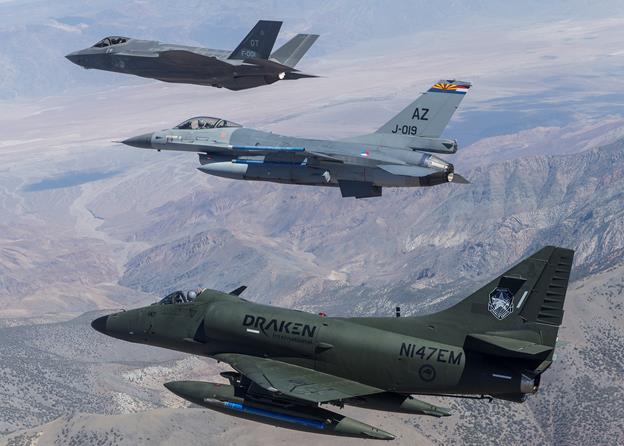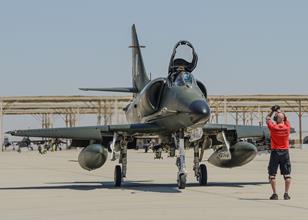
EDWARDS AFB – A-4 Skyhawks have taken to the skies over Edwards in support of operational tests of the F-35A for the Royal Netherlands Air Force. They are part of a tactics development and evaluation exercise initiated by the 323nd Test and Evaluation Squadron and supported by the Joint Strike Fighter Operational Test Team from Aug. 17-28.
“Each service and each country has their own specific test events that they want to test for themselves, for their own service and their own country requirements,” said Rich Radvanyi, JOTT Planning Cell chief.
The JOTT has five operational test squadrons composed of the 31st Test and Evaluation Squadron, the Marines’ VMX-22 squadron, the United Kingdom squadron 17(R), the Dutch 323nd Test and Evaluation Squadron and Navy squadron VX-9.
In support of the exercise, the Royal Netherlands Air Force also brought in six F-16s from the 162nd Fighter Wing, Arizona Air National Guard to serve as either allied or adversary aircraft, along with a KDC-10 Air Refueling tanker from the Royal Netherlands Air Force 334th Transport Squadron at Eindhoven Airport, Netherlands. The JOTT contracted Draken International to provide the small fleet of A-4s that were employed as adversary aircraft with a variety of types of mission sets.

For instance, if the test plan required the F-35 pilot to fly against Russian tactics, the Draken pilots would present the same tactics that a Russian fighter pilot would present.
“A lot of the Draken pilots are former military or some are even current guard or reserve pilots. A lot of them had been adversary air pilots before, so they replicate the tactics of different adversary countries,” said Radvanyi.
Draken International pilot Jeff Scott, who retired as a lieutenant colonel after 27 years in the Marine Corps, has been flying for 17 years and received his wings in an A-4.
“I flew F-35s before I retired and now I’m on the other side flying against them,” said Scott.
The test event will enable an initial assessment of 4th and 5th generation fighter integration, including Link-16 interoperability aspects.
The lessons learned will lay the ground work for future cooperation between 4th and 5th generation fighters and will help shape F-35A tactics for the RNLAF.
“There’s really nothing better than actually going out there and flying and putting the actual aircraft against an actual threat and seeing how it works,” Radvanyi said. “This has been very, very beneficial.”
During the two-week test event, the JOTT organized one large force engagement each day with as many as 12 aircraft flying at a time. While only four Skyhawks flew at a time, there were up to six on the ramp at times.
“It’s been a unique opportunity to see a type of adversary aircraft that you wouldn’t normally see,” said Radvanyi. “The A-4 Skyhawk is not in service with the U.S. military anymore so it’s something that would not normally be seen by the crews that are flying here now.”
According to Scott, Draken International purchased their A-4s from the Royal New Zealand Air Force. Their fleet differs from the A-4s that were once use by the U.S. Navy and Marine Corps because they have been upgraded with F-16A avionics like APG-66 radars, radar warning receivers, heads-up displays and a digital data bus.
They also have electronic attack pods that can be used to simulate special presentation requirements for test events.
“It’s a very reliable airplane,” said Scott, adding that the team at Edwards has been “excellent, everyone has been very supportive.”
Skyhawks were mainly flown by the U.S. Navy and Marine Corps. The Navy’s Blue Angels flight demonstration squadron flew the A-4 Skyhawk II from 1974 to 1986. Skyhawks were also used by the armed forces of Argentina, Australia, Israel, Kuwait, Singapore, Indonesia, Malaysia and New Zealand, and they remained active with several air services into the 2000s.
–